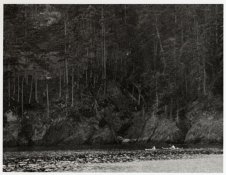The simplest analog method of converting a color negative to a B&W print, as suggested above, is a panchro paper. Panalure has been out of production for some time, but I recently saw some at a local photo store (which is now out of business, and the Panalure long gone); Seagull used to sell a panchro paper as well, and it also is out of production; I don't know that there is such an animal still available.
The second simplest is to contact print the color negative to panchromatic film and develop a reversal positive (which becomes a grayscale copy of the color negative, of course), or use a slide/film duplicator to do the same job (you could also make an enlarged copy negative for contact printing the same way, but this, IMO, more complicated than duplicating the negative at original film size). This avoids the contrast gain of a two-step copy by eliminating the interpositive, though it is dependent on a reliable B&W reversal process -- commercial processing at .dr5 is one possibility, but Kodak and Foma sell reversal kits that work well with any film (a couple test rolls or sheets are surely in order); cross-processing XP2+ in E-6 might work, also. With a bit of experimentation, it's even possible to do reversal with the addition of only a single chemical to those normally used for B&W: you need a bleach that won't rehalogenate the image silver (plus a clearing bath, usually sodium sulphite, needed to remove the bleach, so really two chemicals).











